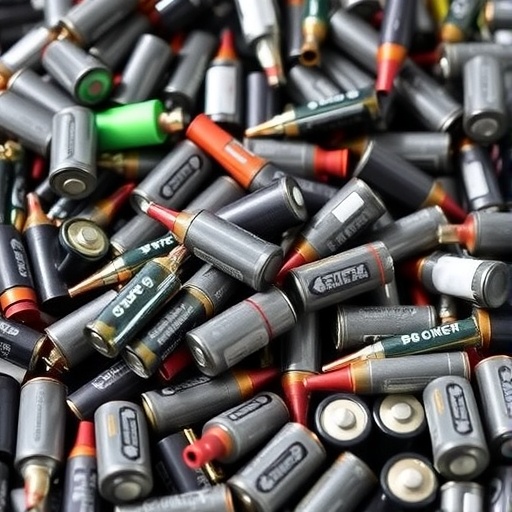A groundbreaking advance in battery recycling technology has emerged from the laboratories of the University of Illinois Urbana-Champaign, where researchers have devised an innovative single-step electrochemical process to reclaim valuable metals from spent battery cathodes and redeposit them onto new electrodes. This pioneering technique, which fundamentally streamlines the recycling journey, promises to dramatically reduce costs, environmental impact, and health risks associated with traditional multi-step recycling practices employed in current industry paradigms.
Battery cathodes, the critical positive components responsible for storing electrical energy, commonly incorporate scarce and costly metals such as cobalt. These metals are not only pivotal for battery performance but are also finite and difficult to procure sustainably. Addressing the growing demand for efficient reuse of these materials, the Illinois research team targeted lithium cobalt oxide cathodes prevalent in consumer electronics like smartphones and laptops. Their electrochemical method deftly dissolves these metal compounds from exhausted battery components using an electrical stimulus and simultaneously deposits them onto fresh cathode substrates within a unified chemical bath.
What distinguishes this technique is its elegant simplicity: a single electrochemical operation replaces the laborious sequence of breakdown, separation, purification, chemical transformation, and recoating traditionally required to recycle battery electrodes. By leveraging the principles of electrodeposition—where electrical currents effect material layering on surfaces—the team hypothesized and demonstrated that the reverse could be harnessed to strip away cathode coatings. Thus, the metals, once solubilized by controlled anodic oxidation, are immediately available to be re-electrodeposited onto a new electrode, effectively closing the loop in one continuous, efficient cycle.
Comprehensive life cycle and economic analyses conducted in collaboration with the Department of Industrial and Enterprise Systems Engineering revealed that this single-step method slashes the cost of cathode recycling to one-eighth that of conventional protocols and reduces environmental footprints by over 50%. This outstanding performance arises from drastically diminished material input requirements, simplified processing setups, and minimized energy consumption. Moreover, the elimination of chemical intermediates and hazardous reagents curtails human health hazards traditionally posed by complex recycling chemistries.
Lead author Jarom Sederholm emphasized the transformative potential conferred by a seamless approach: “Reducing the process to a single step donates profound efficiencies across resource utilization and energy use. This innovation conveys not only fiscal savings but also addresses critical sustainability challenges inherent in battery lifecycle management today.” The research, published in Advanced Functional Materials, underscores a paradigm shift by demonstrating viable industrial-scale scalability without compromising electrochemical robustness or cathode performance.
The inspiration sprang from a conceptual dialogue about electrodeposition mechanisms, a technique well-explored in their lab. The team speculated on the feasibility of reversing electrodeposition to dissolve coatings electrochemically. Proof-of-concept experiments validated that applying precise voltages in an engineered saline solution swiftly stripped lithium cobalt oxide from old cathodes, while subsequent current reversal deposited the metals onto fresh electrodes. This discovery elegantly harnesses electrochemical kinetics and thermodynamics to enable an efficient recycling loop within a single chemical environment.
Beyond consumers’ ubiquitous lithium cobalt oxide batteries, the technique holds promise for broader cathode chemistries incorporating nickel and manganese oxides, though adapting parameters to accommodate different materials remains an active frontier. Furthermore, the process offers a platform to investigate the fate of polymeric binders commonly present in cathodes and anodes, such as polyvinylidene fluoride (PVDF), which can pose environmental challenges when improperly managed. The team is pursuing methods to reduce binder release and promote their recovery, further enhancing the sustainability profile.
Paul Braun, professor and project lead, highlighted the inefficiencies and environmental liabilities of current recycling workflows, which demand extensive material breakdown, chemical treatments, and energy-intensive purification stages. This new electrochemical protocol judiciously consolidates metal recovery and electrode fabrication into a single electrochemical step, obviating multiple chemical baths and reducing waste generation. The simplification not only aligns with green chemistry principles but also portends substantial cost and regulatory compliance advantages for battery manufacturers and recyclers.
Interdisciplinary collaboration was key to this advance, combining expertise in materials science, chemical engineering, and industrial systems to interrogate every facet of process feasibility. Economists and environmental scientists rigorously modeled operational scenarios, elucidating the comprehensive benefits across supply chains and end-of-life battery treatment. The findings position this electrochemical recycling strategy as a potential cornerstone for circular economy initiatives targeting critical energy storage materials.
This newly unveiled approach opens fresh avenues for enhancing the sustainability and economic accessibility of rechargeable batteries, a cornerstone technology underpinning electrification and decarbonization efforts worldwide. By significantly lowering the cost and hazard profile of recycling, it alleviates resource scarcity pressures and supports responsible stewardship of finite elements essential to next-generation energy technologies.
Having filed an international patent application to protect the underlying technology, the research group is now focused on scaling production and extending the methodology to anode materials and emerging cathode formulations. Their ultimate vision envisions a more resilient and sustainable battery ecosystem enabled by innovative electrochemical recycling technologies that harmonize engineering ingenuity with environmental responsibility.
As global electrification intensifies, securing efficient battery recycling pathways will be imperative to meet soaring demand without exacerbating ecological degradation. This single-step electrochemical recycling breakthrough provides a compelling blueprint and scientific foundation for innovative circular material flows, promising to reshape battery manufacturing and end-of-life management for decades to come.
Subject of Research: Electrochemical Battery Recycling Technology
Article Title: Single-Step Electrochemical Battery Recycling
News Publication Date: 19-Aug-2025
Web References:
DOI: 10.1002/adfm.202511009ope
Image Credits: The Grainger College of Engineering at the University of Illinois Urbana-Champaign
Keywords: Electrochemistry, Batteries, Battery Recycling, Lithium Cobalt Oxide, Electrodeposition, Sustainable Materials, Circular Economy, Energy Storage




